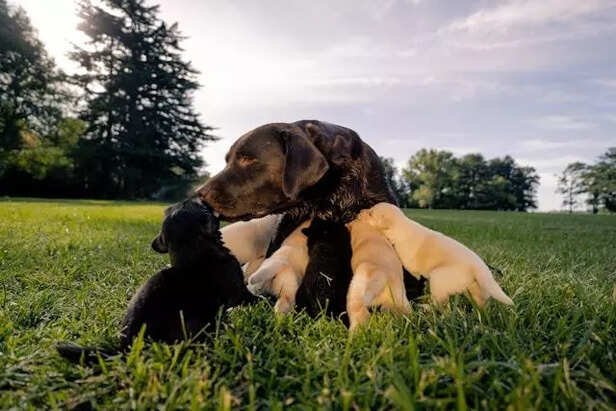Are Small Dogs Really More Aggressive? The Science Says Yes
Tanisha Kumari | Sep 30, 2025, 18:25 IST
Small dogs
( Image credit : Unsplash )
Many pet lovers think large dogs are aggressive but research shows small dogs bark more and act more aggressive. Fear, genetics and spoiled habits make little breeds snappy. But with training and regular exercise, they can become calm companions. Here it explains the science, real causes and best ways to stop small dog aggression.
Many people think big dogs are scary because of their size but studies show that small dogs bark more and show more bad behavior than large dogs and this can come as a surprise for many new pet owners who expect small dogs to be calm and easy.
When scientists studied dog habits they found a clear pattern that small breeds like Chihuahuas, Dachshunds and Jack Russells showed more aggression than big breeds. This happened with strangers, with other pets and even sometimes with their own family. Big dogs may look fierce but they showed less bad temper in most cases.
Experts believe this is not just about the dog. It is also about how people treat small dogs. Many owners spoil little breeds, carry them around, or let them get away with bad habits that they would never accept in a big dog. This builds aggressive behavior over time.
Why Small Dogs Act Aggressive

A main reason is fear as small dogs know they are tiny compared to humans and large animals. They often bark or bite because they are scared and this is their way of protecting themselves.
Genetics also plays a role. Some small breeds were made to guard farms or hunt rodents. These instincts are still there, even in modern homes. So their bold and sharp nature comes out when they feel challenged.The way the owner trains them is another key. If you laugh when a small dog growls, or ignore its snapping, you teach it that this behavior is okay. Over time, this makes the dog more bossy and even harder to manage.
The Science Behind
Researchers at universities studied thousands of dogs. They used surveys and behavior tests. The results showed again and again that small breeds scored higher on aggression than most large breeds.
Dog behavior groups also noticed that injury cases from dog bites often involve small dogs. Though the bites may not be as powerful as a large dog’s bite, the number of attempts is very high. This proves that the aggression is real and not just an act.
The data also shows that body size and brain function may be linked. Smaller dogs have brains that handle stress differently. They tend to react faster and louder than calm large dogs.
Small Dogs and Family Life

Many families bring home small dogs thinking they are safer with kids. But experts warn that is not always true. A small dog may have a short temper and snap if a child touches it wrong.
This does not mean small dogs are bad pets but it means owners should give small dogs the same respect, exercise and training they give larger breeds. When trained right, small dogs can be friendly, playful and gentle.
It is also important to let small dogs walk on their own, meet other pets and learn rules. Carrying them all the time can make them nervous and even more reactive.
The best way to stop aggression is early training. Owners should use clear rules, rewards for calm behavior and social time with people and other dogs.
Regular exercise also helps. A tired dog is a calm dog. When small dogs burn energy by walking and playing, they feel less need to bark or snap at others.
Another tip is to give them challenges like training games or puzzle toys. This helps them use their brain and stay balanced.
Why Big Dogs Seem Kinder

Big dogs often get strict training early because their size can cause harm if they misbehave. Owners usually set strong rules from the start which reduces bad behavior.
Unlike small dogs, big breeds are not picked up or pampered as much. They learn to live on the ground, face other dogs and handle people calmly. This daily habit makes them more controlled and less likely to be bratty.
The calm nature of big dogs is also linked to their breeding history. Many giant breeds were used for guarding or work. They needed patience and steady temper to do their jobs well.
Not every small dog is aggressive. Many little breeds are loving and kind. How a dog acts depends on both its nature and the care it gets.
Some small dogs live peacefully with children, cats and even big dogs and this is proof that with correct care they can be just as gentle as a large breed.
The size of the dog does not decide everything. Training, social life, and owner effort shape the dog’s true behavior.
Science shows small dogs are often more aggressive than big ones. But this does not make them bad pets. It means they need better guidance and stronger rules. Owners must treat them as real dogs and not as toys.
With love, activity and training small dogs can be just as loyal and sweet as any large dog. The key is respecting their nature, meeting their needs and teaching them early. In the end, a balanced dog of any size is a happy family member.
Celebrate the bond with your pets, explore Health & Nutrition, discover Breeds, master Training Tips, decode Behavior, and set out on exciting Travel Tails with Times Pets!
Frequently Asked Questions (FAQs)
When scientists studied dog habits they found a clear pattern that small breeds like Chihuahuas, Dachshunds and Jack Russells showed more aggression than big breeds. This happened with strangers, with other pets and even sometimes with their own family. Big dogs may look fierce but they showed less bad temper in most cases.
Experts believe this is not just about the dog. It is also about how people treat small dogs. Many owners spoil little breeds, carry them around, or let them get away with bad habits that they would never accept in a big dog. This builds aggressive behavior over time.
Why Small Dogs Act Aggressive

Aggression
( Image credit : Unsplash )
A main reason is fear as small dogs know they are tiny compared to humans and large animals. They often bark or bite because they are scared and this is their way of protecting themselves.
Genetics also plays a role. Some small breeds were made to guard farms or hunt rodents. These instincts are still there, even in modern homes. So their bold and sharp nature comes out when they feel challenged.The way the owner trains them is another key. If you laugh when a small dog growls, or ignore its snapping, you teach it that this behavior is okay. Over time, this makes the dog more bossy and even harder to manage.
The Science Behind Small Dog Aggression
Dog behavior groups also noticed that injury cases from dog bites often involve small dogs. Though the bites may not be as powerful as a large dog’s bite, the number of attempts is very high. This proves that the aggression is real and not just an act.
The data also shows that body size and brain function may be linked. Smaller dogs have brains that handle stress differently. They tend to react faster and louder than calm large dogs.
Small Dogs and Family Life

Family life
( Image credit : Unsplash )
Many families bring home small dogs thinking they are safer with kids. But experts warn that is not always true. A small dog may have a short temper and snap if a child touches it wrong.
This does not mean small dogs are bad pets but it means owners should give small dogs the same respect, exercise and training they give larger breeds. When trained right, small dogs can be friendly, playful and gentle.
It is also important to let small dogs walk on their own, meet other pets and learn rules. Carrying them all the time can make them nervous and even more reactive.
How to Stop Aggressive Behavior in Small Dogs
Regular exercise also helps. A tired dog is a calm dog. When small dogs burn energy by walking and playing, they feel less need to bark or snap at others.
Another tip is to give them challenges like training games or puzzle toys. This helps them use their brain and stay balanced.
Why Big Dogs Seem Kinder

Big dogs
( Image credit : Unsplash )
Big dogs often get strict training early because their size can cause harm if they misbehave. Owners usually set strong rules from the start which reduces bad behavior.
Unlike small dogs, big breeds are not picked up or pampered as much. They learn to live on the ground, face other dogs and handle people calmly. This daily habit makes them more controlled and less likely to be bratty.
The calm nature of big dogs is also linked to their breeding history. Many giant breeds were used for guarding or work. They needed patience and steady temper to do their jobs well.
Do All Small Dogs Act Aggressive
Some small dogs live peacefully with children, cats and even big dogs and this is proof that with correct care they can be just as gentle as a large breed.
The size of the dog does not decide everything. Training, social life, and owner effort shape the dog’s true behavior.
Small Dogs Need Big Care
With love, activity and training small dogs can be just as loyal and sweet as any large dog. The key is respecting their nature, meeting their needs and teaching them early. In the end, a balanced dog of any size is a happy family member.
Celebrate the bond with your pets, explore Health & Nutrition, discover Breeds, master Training Tips, decode Behavior, and set out on exciting Travel Tails with Times Pets!
Frequently Asked Questions (FAQs)
- Are bigger dogs easier to train?
Bigger dogs are easier to train. - What is the most yappy dog?
Chihuahuas are the most yappy dogs. - What is the best age to train a small dog?
Dogs should be trained between 8 and 16 weeks of age.
